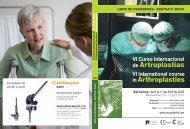cadera / hip - Active Congress.......
cadera / hip - Active Congress.......
cadera / hip - Active Congress.......
You also want an ePaper? Increase the reach of your titles
YUMPU automatically turns print PDFs into web optimized ePapers that Google loves.
VIERNES / FRIDAY<br />
292<br />
for proximal seating of the tibial component if<br />
the rest of the tibial architecture is severely<br />
destroyed. In the worst cases, all cancellous<br />
bone is gone, leaving a large cavitary<br />
defect and substantial defi ciency of the tibial<br />
rim. Long-stem fi xation is advisable in these<br />
cases regardless of whether block allografting<br />
or morselized allografting technique is used.<br />
When morselized graft is used, the tibial tray<br />
should seat on the intact portion of the tibial<br />
rim, and the stem should engage the isthmus<br />
of the tibia. As with the femoral component,<br />
the tightly fi t diaphyseal stem maintains stability<br />
and prevents tilting of the component,<br />
so that massive defects may be fi lled with<br />
allograft and protected until healing and bone<br />
formation occur in the grafted area.<br />
GRAFTING TECHNIQUE<br />
Block allografts traditionally have been used<br />
for massive bone defi ciencies, but their complication<br />
rates are high, and the destructive<br />
effects of allograft rejection can limit their<br />
long-term success. Large segments of allograft<br />
also heal slowly, are never replaced by<br />
new bone, and weaken as the ossifi cation and<br />
vascularization front proceeds. In contrast,<br />
morselized allograft has proven structurally<br />
reliable for both small and large defects while<br />
supporting new bone formation. Morsels that<br />
are 1 cm in diameter maintain their integrity<br />
long enough to act as a substrate for new<br />
bone formation. Morsels less than 0.5 to<br />
1 cm in diameter tend to be resorbed while<br />
those larger than 1 cm incorporate slowly, if<br />
ever, and tend to collapse.<br />
Rejection can be a major problem with allograft<br />
because marrow is immunogenic.<br />
However, marrow elements can be thoroughly<br />
removed from morselized allograft to<br />
prevent the infl ammatory response and loss<br />
of graft and to capitalize on the osteoconductive<br />
potential of the allograft. The allograft<br />
acts as scaffolding for new bone growth, and<br />
although it is not osteoinductive, demineralized<br />
bone (mildly osteoinductive) and bone<br />
marrow aspirate (highly osteoinductive) can<br />
be added to the allograft to enhance bone<br />
formation. The surrounding bone structure<br />
supplies most of the osteoinductive activity<br />
because metaphyseal bone has a rich blood<br />
supply and maintains the capacity to heal<br />
even after repeated failed arthroplasty.<br />
Grafting preparation and placement<br />
Fresh-frozen cancellous allograft in morsels<br />
measuring 0.5 to 1 cm in diameter is soaked<br />
for fi ve to ten minutes in normal saline solution<br />
that contains polymyxin 500,000 units,<br />
bacitracin 50,000 units, and cephazolin 1 g<br />
of per liter. The fl uid is removed and 10 cc<br />
of powdered demineralized cancellous bone<br />
is added to each 30 cc of the cancellous<br />
morsels. Bone fragments and diaphyseal<br />
reamings are added to improve the osteoinductive<br />
potential. This mixture is packed<br />
into the bone defects, then the implants are<br />
impacted so as to seat on the remnant of viable<br />
bone while compacting the morselized<br />
bone graft.<br />
MANAGEMENT OF<br />
PERIPROSTHETIC<br />
FRACTURES IN TKA<br />
R. “Dickey” Jones, M.D.<br />
U.T. Southwestern Medical Center,<br />
Dallas, TX, USA





